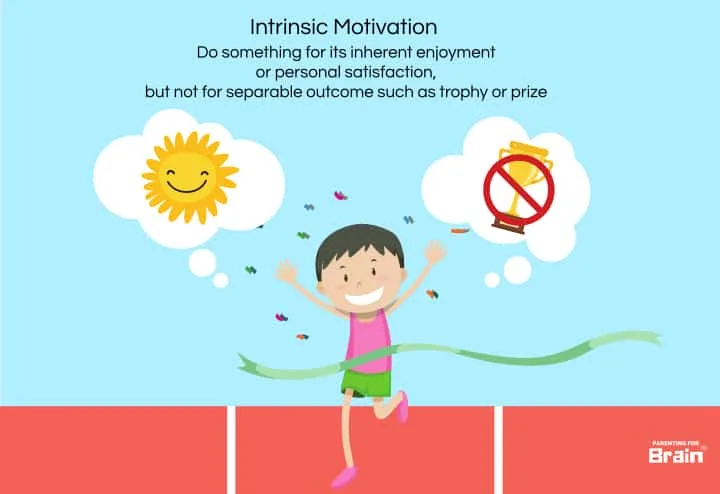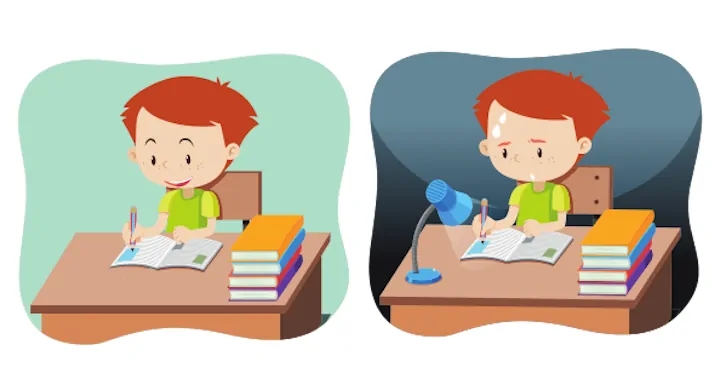TABLE OF CONTENTS
What is Intrinsic Motivation
Intrinsic motivation is an inner drive that propels a person to pursue an activity, not for external rewards, but because the action itself is enjoyable. In other words, a person is motivated by the fun, challenge, or satisfaction of an activity, not by an outside outcome, pressure, or reward.
In psychology, intrinsic motivation is known as the best type of motivation.
Intrinsic Definition
To understand intrinsic motivation, we first have to understand what exactly it means for something to be intrinsic.
The word “intrinsic” means that something is inherent by nature. It is sometimes referred to as “inner”, which refers to something coming from within.

In psychology, the two main types of motivation are intrinsic motivation and extrinsic motivation1.
And, as you may have predicted, being extrinsically motivated refers to doing an activity to attain some separable outcome, such as earning a reward or avoiding punishment.
Intrinsic and extrinsic motivations comprise the underlying reasons, attitudes, and goals that give rise to human behavior.
They are essentially the “why” we do what we do.

Intrinsic Motivation Examples
Here are some examples of intrinsic motivation.
- studying math because you enjoy solving problems, not because you want to please your parents
- practicing tennis because it is fun, not because you want to win an award
- playing the piano because you enjoy making music, not to avoid punishment
- reading a novel for pleasure, not because you need to write a book report
- volunteering because you enjoy helping others, not because you want others to like you
- working hard because you enjoy being good at it rather than earning a bonus
- taking a walk to relax instead of losing weight
- playing with your child to enjoy spending time together, not because you want to avoid a tantrum
- saying thank you because you like to show appreciation instead of following social rules
- preparing a meal because you like cooking dishes, not because you are hungry
- making a craft to enjoy being creative rather than selling it for money
- doing chores because you enjoy organizing but because you want to get an allowance
- learning a new language because you enjoy learning new things, not because you want to work overseas
- tutoring little kids because you enjoy teaching them, not because you want to earn a salary
- helping your neighbor because you like helping others, not because you want them to return the favor later
Why Intrinsic Motivation is Good
Intrinsic motivation is considered better than extrinsic motivation because people who are intrinsically motivated are more likely to be1:
- Successful – They achieve better results.
- Committed – They have a stronger sense of personal commitment.
- Persistent – They perform more persistently and are less likely to quit when facing difficulties.
- Creative – They are more creative and more likely to develop novel ideas and solutions. Intrinsic motivation is an important component of creativity.

What are Intrinsic Rewards
We pursue many activities simply for the enjoyment or satisfaction they bring about.
They may include activities like:
- Reading a novel
- Playing a sport
- Learning a new task
- Doing a puzzle
- Volunteering
We don’t necessarily do these activities to produce something or be rewarded in any way, but because we enjoy the tasks and they make us happy or satisfied.
These feelings of enjoyment, happiness, or satisfaction are what psychologists call intrinsic rewards (sometimes called inner or internal rewards).
Intrinsic rewards drive intrinsic motivation.
Here are 4 examples of intrinsic rewards.
- A sense of competence when you master a new task or skill
- A sense of accomplishment when you see success in your work
- A sense of belonging when you participate in group activities
- A sense of meaning when you volunteer in a non-profit or mentor someone
Theories of Motivation
Self-Determination Theory (SDT)
Self-Determination Theory states that a person’s experience of autonomy, competence, and relatedness can affect their intrinsic motivation.
This means intrinsic motivation can be facilitated or undermined under specific conditions2.
Studies have found that one of the most significant motivating factors is the feeling of competence.
For example, when you complete a difficult task or master a new skill successfully, you feel a sense of accomplishment, which makes you happy. You are then intrinsically motivated to do it again or master it even more.
A good illustration of this is playing video games.
Gamers who successfully graduate from one level to the next feel competent. This is one of the reasons why well-designed video games are so addictive. Gamers have an internal motivation to play for the activity and don’t do it for any extrinsic reward3.
So, events and structures that conduce feelings of competence can enhance enjoyment. They include an optimal level of challenges, positive competence feedback, and a lack of demeaning evaluations.
But there is an important piece missing.
Inside motivation is only developed under very specific conditions.
Intrinsic motivation comes from individuals feeling they are doing the activity out of their “free choice.” In other words, one has to think they have the autonomy to choose whether to engage in the behaviors.
In one classic study that perfectly demonstrates this phenomenon, researchers asked college students to work on a puzzle but told only half of the students that they would be paid for doing the work.
After completing the puzzle and taking a short break, the students were left alone to do whatever they wanted. They could continue to work on another puzzle or do other things available in the lab.
It turned out that the students who were not paid were the ones who voluntarily worked on another puzzle.
So, providing an extrinsic reward for the student’s work diminished their desire to do it voluntarily. When an extrinsic reward is imposed, doing the puzzle is no longer a free choice4,5.
Another factor that can impact intrinsic motivation is relatedness, which refers to how well one feels connected, secure, respected, and cared for.
For example, a baby securely attached to their parent shows more desire to explore. They are more motivated to interact with their surroundings and engage in learning. The play is intrinsically motivated.
According to one research, when kids work on an exciting task in the presence of a stranger, their intrinsic motivation decreases if the stranger ignores them and doesn’t respond to their initiation.
People can be intrinsically motivated to do an interesting activity alone. Therefore, relatedness is not a necessary condition for intrinsic motivation. Yet it is still an influential factor affecting one’s intrinsically motivated behavior.
Intrinsic Motivation Theory and Operant Conditioning
One of the most common ways parents motivate their children to adopt a new behavior is to give rewards, such as toys, money, or more time on the iPad.
Parents hope that the child will associate the positive outcome with the behavior and, as a result, are more likely to repeat it.
Using reinforcement to incentivize a target behavior is a learning process called operant conditioning.
Operant conditioning can often bring about a fast change in behavior6. Unfortunately, there is a downside: it doesn’t increase intrinsic motivation for kids.
Although giving rewards can increase behavior momentarily, it only affects one’s extrinsic motivations.
Research shows that extrinsic rewards can undermine intrinsic motivation, demotivating children from acting independently.
In other words, offering extrinsic rewards for an already intrinsically rewarding activity makes it less satisfying to people. The external rewards have become a demotivator instead of a motivator.
This is called the overjustification effect.
The overjustification effect is often seen in companies offering bonuses to boost productivity.
Although employee productivity may rise momentarily, the actual quality of the work performed decreases. And when the bonus runs out, employees are left with reduced inner motivation. The loss in interest and productivity could only be compensated by an even bigger bonus, if it’s even possible at all.

How To Increase Intrinsic Motivation
Fortunately, although we cannot use traditional rewards to motivate people intrinsically, other ways exist to enhance intrinsic motivation.
Here are some intrinsic motivators you can use to get motivated.
1. Look for the Intrinsic Reward
An intrinsic motivator only exists when an activity holds intrinsic value for the person who engages in it, so the activity has to hold such appeal, or there will be no intrinsic motivation.
Look for aspects of the activity that interest you, or internalize the innate reason why you want to participate.
2. Engage in an Optimal Level of Challenge
Challenge yourself with a task that is not easy but not so hard that it is unattainable.
Stretching your limits and achieving success can give you a tremendous sense of competence and boost internal motivation.
3. Seek Positive Feedback
Receiving a badge or recognition for reaching a specific goal or level of task can also provide a sense of competence4.
4. Do It for Yourself
The intrinsic drive can only exist when people freely decide to engage and make it an intrinsic goal.
Choose a task that naturally interests you and do it for pure enjoyment, with no strings attached4.
5. Find a buddy
If possible, find a person to do the activity with you.
Look for someone you can relate to and who can provide positive feedback without any demeaning criticism.
Doing something as a team also has the added benefit of helping each other, generating a sense of competence and belonging.
Also See: What motivates your child in school
References
- 1.Deci EL, Ryan RM. Intrinsic Motivation. The Corsini Encyclopedia of Psychology. January 2010. doi:10.1002/9780470479216.corpsy0467
- 2.Ryan RM, Deci EL. Self-determination theory and the facilitation of intrinsic motivation, social development, and well-being. American Psychologist. 2000:68-78. doi:10.1037/0003-066x.55.1.68
- 3.Ryan RM, Rigby CS, Przybylski A. The Motivational Pull of Video Games: A Self-Determination Theory Approach. Motiv Emot. November 2006:344-360. doi:10.1007/s11031-006-9051-8
- 4.Koestner R, Ryan RM, Bernieri F, Holt K. Setting limits on children’s behavior: The differential effects of controlling vs. informational styles on intrinsic motivation and creativity. J Personality. September 1984:233-248. doi:10.1111/j.1467-6494.1984.tb00879.x
- 5.Anderson R, Manoogian ST, Reznick JS. The undermining and enhancing of intrinsic motivation in preschool children. Journal of Personality and Social Psychology. 1976:915-922. doi:10.1037/0022-3514.34.5.915
- 6.Staddon JER, Cerutti DT. Operant Conditioning. Annu Rev Psychol. February 2003:115-144. doi:10.1146/annurev.psych.54.101601.145124
